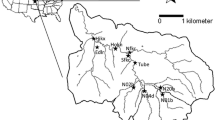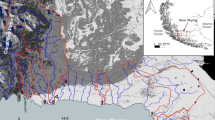Abstract
Dissolved organic carbon (DOC) plays an important role in surface water chemistry and ecology and trends in DOC concentration have been also associated with shifts in terrestrial carbon pools. Numerous studies have reported long-term trends in DOC concentration; however, some studies consider changes in average measured DOC whereas other compute discharge weighted concentrations. Because of differences in reporting methods and variable record lengths it is difficult to compare results among studies and make regional generalizations. Furthermore, changes in stream discharge may impact long-term trends in DOC concentration and the potentially subtle effect of shifts in stream flow may be missed if only measured DOC concentrations are considered. In this study we compare trends in volume-weighted vs. average measured DOC concentration between 1980 and 2001 at seven headwater streams in south-central Ontario, Canada that vary in wetland coverage and DOC (22-year mean vol. wt.) from 3.4 to 10.6 mg l−1. On average, annual measured DOC concentrations were 13–34% higher than volume-weighted values, but differences of up to 290% occurred in certain years. Estimates of DOC flux were correspondingly higher using measured concentration values. Both measured and volume-weighted DOC concentrations increased significantly between 1980 and 2001, but slopes were larger in measured data (0.04–0.35 mg l−1 year−1 compared with 0.05–0.15 mg l−1 year−1) and proportional increases at the most wetland-influenced sites ranged from 32 to 43% in volume-weighted DOC and from 52 to 75% in measured DOC. In contrast, DOC flux did not change with time when estimated using either method, because of the predominant influence of stream flow on DOC export. Our results indicate that changes in stream flow have an important impact on trends in DOC concentration, and extrapolation of trend results from one region to another should be made cautiously and consider methodological and reporting differences among sites.

Similar content being viewed by others
References
Agren A, Buffam I, Jansson M, Laudon H (2007) Importance of seasonality and small streams for landscape regulation of DOC export. J Geophys Res 112. doi:10.1029/2006JG000381
Bouchard A (1997) Recent lake acidification and recovery trends in southern Quebec, Canada. Water Air Soil Pollut 94:225–245
Boyer EW, Hornberger GM, Bencala KE, McKnight DM (1997) Response characteristics of DOC flushing in an alpine catchment. Hydrol Process 11:1635–1647
Burns DA, McHale MR, Driscoll CT, Roy KM (2006) Response of surface water chemistry to reduced levels of acid precipitation: comparison of trends in two regions of New York, U.S.A. Hydrol Process 20:1611–1627
Dann MS, Lynch JA, Corbett ES (1986) Comparison of methods for estimating sulphate export from a forested watershed. J Environ Qual 15:140–145
Dillon PJ, Molot LA (2005) Long-term trends in catchment export and lake retention of dissolved organic carbon, dissolved organic nitrogen, total iron and total phosphorus: the Dorset, Ontario, study, 1978–1998. J Geophys Res 110. doi:10.1029/2004JG000003
Dittman JA, Driscoll CT, Groffman PM, Fahey TJ (2007) Dynamics of nitrogen and dissolved organic carbon at the Hubbard Brook Experimental Forest. Ecology 88:1153–1166
Driscoll CT, Driscoll KM, Roy KM, Mitchell MJ (2003) Chemical response of lakes in the Adirondack Region of New York to declines in acidic deposition. Environ Sci Technol 37:2036–2042
Eimers MC, Dillon PJ, Schiff SL (2004a) A S-isotope approach to determine the relative contribution of redox processes to net SO4 export from upland, and wetland-dominated catchments. Geochim Cosmochim Acta 68:3665–3674
Eimers MC, Dillon PJ, Schiff SL (2004b) Sulphate flux from an upland catchment in south-central Ontario, Canada. Water Air Soil Pollut 152:3–21
Eimers MC, Buttle JM, Watmough SA (2007a) Influence of seasonal changes in runoff and extreme events on DOC trends in wetland and upland-draining streams. Can J Fish Aquat Sci (in press)
Eimers MC, Watmough SA, Buttle JM (2007b) Examination of the potential relationship between droughts, sulphate and dissolved organic carbon at a wetland-draining stream. Global Change Biol (in press)
Evans CD, Monteith DT, Cooper DM (2005) Long-term increases in surface water dissolved organic carbon: observations, possible causes and environmental impacts. Environ Pollut 137:55–71
Evans CD, Chapman PJ, Clark JM, Monteith DT, Cresser MS (2006) Alternative explanations for rising dissolved organic carbon export from organic soils. Global Change Biol 12:2044–2053
Findlay SEG (2005) Increased carbon transport in the Hudson River: unexpected consequence of nitrogen deposition? Front Ecol Environ 3:133–137
Forsius M, Vuorenmaa J, Mannio J, Syri S (2003) Recovery from acidification of Finnish lakes: regional patterns and relations to emission reductions policy. Sci Tot Environ 310:121–132
Freeman C, Evans CD, Monteith DT, Reynolds B, Fenner N (2001) Export of carbon from peat soils. Nature 412:785
Freeman C, Fenner N, Ostle NJ, Kang H, Dowrick DJ, Reynolds B, Lock MA, Sleep D, Hughes S, Hudson J (2004) Export of dissolved organic carbon from peatlands under elevated carbon dioxide levels. Nature 430:195–198
Hejzlar J, Dubrovsky M, Buchtele J, Ruzicka M (2003) The apparent and potential effects of climate change on the inferred concentration of dissolved organic matter in a temperate stream (Malse River, South Bohemia). Sci Total Environ 310:143–152
Hinton MJ, Schiff SL, English MC (1997) The significance of runoff events for the concentration and export of dissolved organic carbon from two Precambrian Shield watersheds. Biogeochemistry 36:67–88
Hinton MJ, Schiff SL, English MC (1998) Sources and flowpaths of dissolved organic carbon during storms in two forested watersheds of the Precambrian Shield. Biogeochemistry 41:175–197
Hirsch RM, Slack JR, Smith RA (1982) Techniques of trend analysis for monthly water quality data. Water Resour Res 20:107–121
Jeffries DS, Semkin RG, Neureuther R, Seymour M (1988) Ion mass budgets for lakes in the Turkey Lakes Watershed, June 1981–May 1983. Can J Fish Aquat Sci 45:47–58
Jeffries DS, Clair TC, Couture S, Dillon PJ, Dupont J, Keller W, McNicol DK, Turner MA, Vet R, Weeber R (2003) Assessing the recovery of lakes in southeastern Canada. Ambio 32:176–182
Keller W, Heneberry JH, Dixit SS (2003) Decreased acid deposition and the chemical recovery of Killarney, Ontario, lakes. Ambio 32:183–189
Laudon H, Kohler S, Buffam I (2004) Seasonal TOC export from seven boreal catchments in northern Sweden. Aquat Sci 66:223–230
LaZerte BD, Scott L (1996) Soil water leachate from two forested catchments on the Precambrian Shield, Ontario. Can J For Res 26:1353–1365
Likens GE, Bormann FH, Pierce RS, Eaton JS, Johnson NM (1977) Biogeochemistry of a forested ecosystem. Springer-Verlag, New York, p 146
Mallory ML, McNicol DK, Cluis DA, Laberge C (1988) Chemical trends and status of small lakes near Sudbury, Ontario, 1983–1995: evidence of continued chemical recovery. Can J Fish Aquat Sci 55:63–75
Mulholland PJ, Hill WR (1997) Seasonal patterns in streamwater nutrient and dissolved organic carbon concentrations: separating catchment flow path and in-stream effects. Water Resour Res 33:1297–1306
Pastor J, Solin J, Bridgham SD, Updegraff K, Harth C, Weishampel P, Dewey B (2003) Global warming and the export of dissolved organic carbon from boreal peatlands. Oikos 100:380–386
Pregitzer K, Zak DR, Burton AJ, Ashby JA, MacDonald NW (2004) Chronic nitrate additions dramatically increase the export of carbon and nitrogen from northern hardwood ecosystems. Biogeochemistry 68:179–197
Qualls RG (2000) Comparison of the behaviour of soluble organic and inorganic nutrients in forest soils. For Ecol Manage 138:29–50
Renzetti AVE, Taylor CH, Buttle JM (1992) Subsurface flow in a shallow soil Canadian Shield watershed. Nordic Hydrol 4:209–226
Roulet N, Moore TR (2006) Browning the waters. Nature 444:283–284
Scheider WA, Moss JJ, Dillon PJ (1979) Measurement and uses of hydraulic and nutrient budgets. US EPA 440/5-79-001, Washington, DC
Schiff SL, Aravena R, Mewhinney E, Elgood R, Warner B, Dillon PJ, Trumbore S (1998) Precambrian Shield wetlands: hydrologic control of the sources and export of dissolved organic matter. Clim Change 40:167–188
Schindler DW, Curtis PJ, Bayley SE, Parker BR, Beaty KG, Stainton MP (1997) Climate-induced changes in the dissolved organic carbon budgets of boreal lakes. Biogeochemistry 36:9–28
Skjelkvåle BL, Mannio J, Wilander A, Andersen T (2001) Recovery from acidification of lakes in Finland, Norway and Sweden. Hydrol Earth Syst Sci 5:327–337
Skjelkvåle BL, Stodard JL, Jeffries DS et a1 (2005) Regional scale evidence for improvements in surface water chemistry: 1990–2001. Environ Pollut 137:165–176
Tranvik LJ, Jansson M (2002) Climate change (communication arising): terrestrial export of organic carbon. Nature 415:861–862
Turmel M-C, Turgeon JML, François C, Cloutier-Hurteau B (2005) Seasonal variations of the transport of dissolved organic carbon in the intermittent stream draining the Hermine headwater catchment on the Canadian Shield. Rev Sci Eau 18:353–380
Vuorenmaa J, Forsius M, Mannio J (2006) Increasing trends of total organic carbon concentrations in small forest lakes in Finland from 1987 to 2003. Sci Total Environ 365:47–65
Worrall F, Burt TP (2005) Predicting the future DOC flux from upland peat catchments. J Hydrol 300:126–139
Worrall F, Burt TP, Shedden R (2003) Long terms records of riverine carbon flux. Biogeochemistry 64:165–178
Worrall F, Harriman R, Evans CD et al (2004) Trends in dissolved organic carbon in UK rivers and lakes. Biogeochemistry 70:369–402
Acknowledgements
Data used in this study were provided by the Ontario Ministry of Environment Dorset Environmental Science Centre, and were produced through the hard work and dedication of a large number of staff and students both past and present. Support from an NSERC postdoctoral fellowship is also gratefully acknowledged. This paper is dedicated to the memory of Lem Scott.
Author information
Authors and Affiliations
Corresponding author
Rights and permissions
About this article
Cite this article
Eimers, M.C., Watmough, S.A. & Buttle, J.M. Long-term trends in dissolved organic carbon concentration: a cautionary note. Biogeochemistry 87, 71–81 (2008). https://doi.org/10.1007/s10533-007-9168-1
Received:
Accepted:
Published:
Issue Date:
DOI: https://doi.org/10.1007/s10533-007-9168-1




